Trench-Assisted Multicore Fiber with Single Supermode Transmission and Nearly Zero Flattened Dispersion
Abstract
:1. Introduction
2. Fundamental Theories
3. Structure and Modal Properties of the Six-Core TA-MCF
4. Structural Parameter Influence on the Dispersion
5. Design of Flattened Dispersion TA-MCFs with Low Bending Loss
6. Conclusions
Author Contributions
Funding
Acknowledgments
Conflicts of Interest
References
- Goel, A.; Pandey, G. Design of broadband dispersion flattened fiber for DWDM system: Performance analysis using various modulation formats. Opt. Fiber Technol. 2018, 42, 109–118. [Google Scholar] [CrossRef]
- Matsui, T.; Zhou, J.; Nakajima, K.; Sankawa, I. Dispersion-flattened photonic crystal fiber with large effective area and low confinement loss. J. Lightwave Technol. 2006, 23, 4178–4183. [Google Scholar] [CrossRef]
- Liu, X.; Han, L.H.; Jia, X.Y.; Wang, J.L.; Yu, F.Y.; Yu, Z.Y. Design of hybrid-core PCF with nearly-zero flattened dispersion and high nonlinearity. Chin. Opt. Lett. 2015, 13, 17–21. [Google Scholar] [CrossRef]
- Maji, P.S.; Chaudhuri, P.R. Gain and bandwidth investigation in a near-zero ultra-flat dispersion PCF for optical parametric amplification around the communication wavelength. Appl. Opt. 2015, 54, 2363–3272. [Google Scholar] [CrossRef]
- Wang, W.; Hou, L.T.; Song, J.J.; Zhou, G.Y. Design of double cladding dispersion flattened photonic crystal fiber with deformation insensitive outer cladding air-holes. Opt. Commun. 2009, 282, 3468–3472. [Google Scholar] [CrossRef]
- Yin, A.H.; Xiong, L. Characteristics analysis of extruded elliptical hole photonic crystal fibers with square air-core. Optik 2014, 125, 4069–4071. [Google Scholar] [CrossRef]
- Wang, W.; Hou, L.T.; Liu, Z.L.; Zhou, G.Y. Validity condition of separating dispersion of PCFs into material dispersion and geometrical dispersion. Chin. Opt. Lett. 2009, 7, 768–770. [Google Scholar] [CrossRef]
- Kunimasa, S.; Koshiba, M. Chromatic dispersion control in photonic crystal fibers: Application to ultra-flattened dispersion. Opt. Express 2003, 11, 843–852. [Google Scholar] [CrossRef]
- Wu, T.L.; Chao, C.H. A novel ultraflattened dispersion photonic crystal fiber. IEEE Photonic Technol. Lett. 2004, 17, 67–69. [Google Scholar] [CrossRef]
- Kaijage, S.F.; Namihira, Y.; Hai, N.H.; Begum, F.; Razzak, S.M.A.; Kinjo, T.; HIGA, H.; Zou, N.Y. Multiple defect-core hexagonal photonic crystal fiber with flattened dispersion and polarization maintaining properties. Opt. Rev. 2008, 15, 31–37. [Google Scholar] [CrossRef]
- Wang, D.; Wang, L.L. Design of topas microstructured fiber with ultra-flattened chromatic dispersion and high birefringence. Opt. Commun. 2011, 284, 5568–5571. [Google Scholar] [CrossRef]
- Martynkien, T.; Pysz, D.; Ryszard, S.; Ryszard, B. All-solid microstructured fiber with flat normal chromatic dispersion. Opt. Lett. 2014, 39, 2342–2345. [Google Scholar] [CrossRef] [PubMed]
- Klimczak, M.; Siwicki, B.; Skibiński, P.; Pysz, D.; Stepień, R.; Heidt, A.; Radzewicz, C.; Buczyński, R. Coherent supercontinuum generation up to 23 µm in all-solid soft-glass photonic crystal fibers with flat all-normal dispersion. Opt. Express 2014, 22, 18824–18832. [Google Scholar] [CrossRef] [PubMed]
- Su, W.; Lou, S.Q.; Zou, H.; Han, B.L. A highly nonlinear photonic quasi-crystal fiber with low confinement loss and flattened dispersion. Opt. Fiber Technol. 2014, 20, 473–477. [Google Scholar] [CrossRef]
- Hsu, J.M. Tailoring of nearly zero flattened dispersion photonic crystal fibers. Opt. Commun. 2016, 316, 104–109. [Google Scholar] [CrossRef]
- Lu, D.K.; Li, X.H.; Zeng, G.H.; Liu, J. Dispersion Engineering in Single-Polarization Single-Mode Photonic Crystal Fibers for a Nearly Zero Flattened Profile. IEEE Photonics J. 2017, 9, 1–8. [Google Scholar] [CrossRef]
- Szostkiewicz, L.; Napierala, M.; Ziolowicz, A.; Pytel, A.; Tenderenda, T.; Nasilowski, T. Cross talk analysis in multicore optical fibers by supermode theory. Opt. Lett. 2016, 41, 3759–3762. [Google Scholar] [CrossRef] [PubMed]
- Yi, C.S.; Zhang, P.Q.; Dai, S.X.; Wang, X.S.; Wu, Y.H.; Xu, T.F.; Nie, Q.H. Multicore chalcogenide photonic crystal fibers for large mode area and mode shaping. Opt. Commun. 2013, 311, 270–274. [Google Scholar] [CrossRef]
- Wei, W.; Zhang, X.Y.; Huang, Q.; Ren, X.M. Analysis of dispersions of coupled asymmetric subwavelength-diameter wires. Optik 2014, 125, 2749–2751. [Google Scholar] [CrossRef]
- Xia, C.; Bai, N.; Ozdur, I.; Zhou, X.; Li, G.F. Supermodes for optical transmission. Opt. Express 2011, 19, 16653–16664. [Google Scholar] [CrossRef]
- Zhou, C.; Zhang, H.K.; Song, P.; Wang, J.; Li, X. Design and optimization of a multi-cores photonic crystal fiber for spatial flat in-phase supermode laser output. Opt. Fiber Technol. 2015, 21, 160–163. [Google Scholar] [CrossRef]
- Jollivet, C.; Mafi, A.; Flamm, D.; Duparré, M.; Schuster, K.; Grimm, S.; Schülzgen, A. Mode-resolved gain analysis and lasing in multi-supermode multi-core fiber laser. Opt. Express 2014, 22, 30377–30386. [Google Scholar] [CrossRef] [PubMed]
- Richardson, D.J.; Fini, J.M.; Nelson, L.E. Space-division multiplexing in optical fibres. Nat. Photonics 2013, 7, 354–362. [Google Scholar] [CrossRef] [Green Version]
- Xiang, S.; Hu, X.W.; Yang, L.Y.; Dai, N.L.; Wu, J.J.; Zhang, F.F.; Peng, J.G.; Li, H.Q.; Li, J.Y. Helical long-period grating manufactured with a CO2 laser on multicore fiber. Opt. Express 2017, 25, 10405–10412. [Google Scholar] [CrossRef] [PubMed]
- Li, X.; Sun, B.; Yu, Y. Ultra-wide bandwidth wavelength selective couplers based on the all solid multi-core Ge-doped fibre. Opto-Electron. Rev. 2014, 22, 166–170. [Google Scholar] [CrossRef] [Green Version]
- Fernandes, L.A.; Grenier, J.R.; Aitchison, J.S.; Herman, P.R. Fiber optic stress-independent helical torsion sensor. Opt. Lett. 2015, 40, 657–660. [Google Scholar] [CrossRef] [PubMed]
- Xia, C.; Eftekhar, M.A.; Correa, R.A.; Antonio-Lopez, J.E.; Schülzgen, A.; Christodoulides, D.; Li, G.F. Supermodes in Coupled Multi-Core Waveguide Structures. IEEE J. Sel. Top. Quant. 2016, 22, 196–207. [Google Scholar] [CrossRef]
- Jin, W.X.; Jian, S.S. Numerical and simulation analyses on supermode characteristics of dual-core fiber and four-core fiber. Optik 2017, 132, 32–38. [Google Scholar] [CrossRef]
- Ren, W.H.; Tan, Z.W. A study on the coupling coefficients for multi-core fibers. Optik 2016, 127, 3248–3252. [Google Scholar] [CrossRef]
- Zheng, S.W.; Ren, G.B.; Lin, Z.; Jian, S.S. Mode-coupling analysis and trench design for large-mode-area low-cross-talk multicore fiber. Appl. Opt. 2013, 52, 4541–4548. [Google Scholar] [CrossRef]
- Wang, Z.Q.; Ye, J.J.; Zhao, C.L.; Zhang, Z.X.; Wang, J.F.; Zhang, S.Q.; Jin, S.Z. Design of large-mode-area single-mode optical fiber with lowing bending loss for Raman distributed temperature sensor. Opt. Fiber Technol. 2013, 19, 671–676. [Google Scholar] [CrossRef]
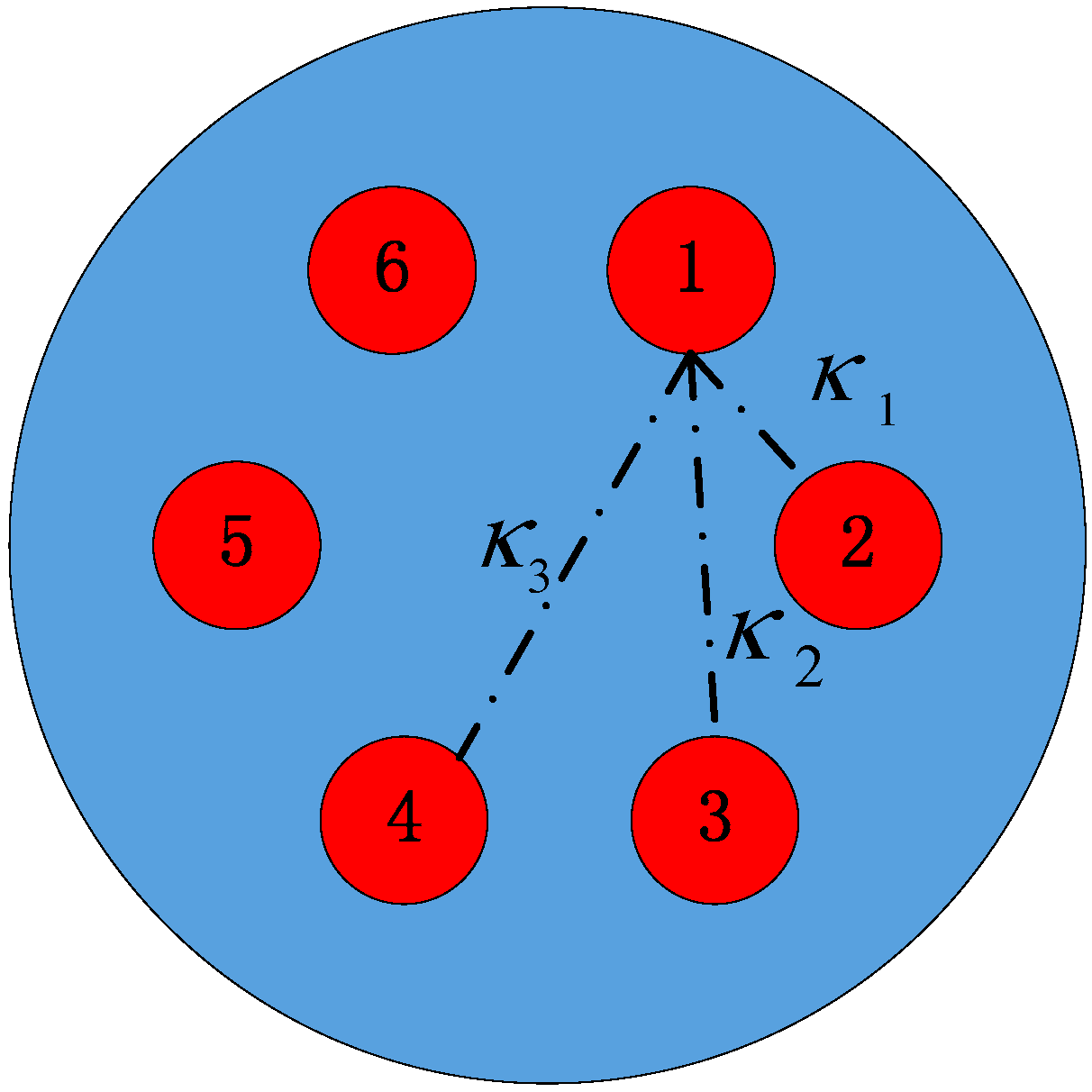
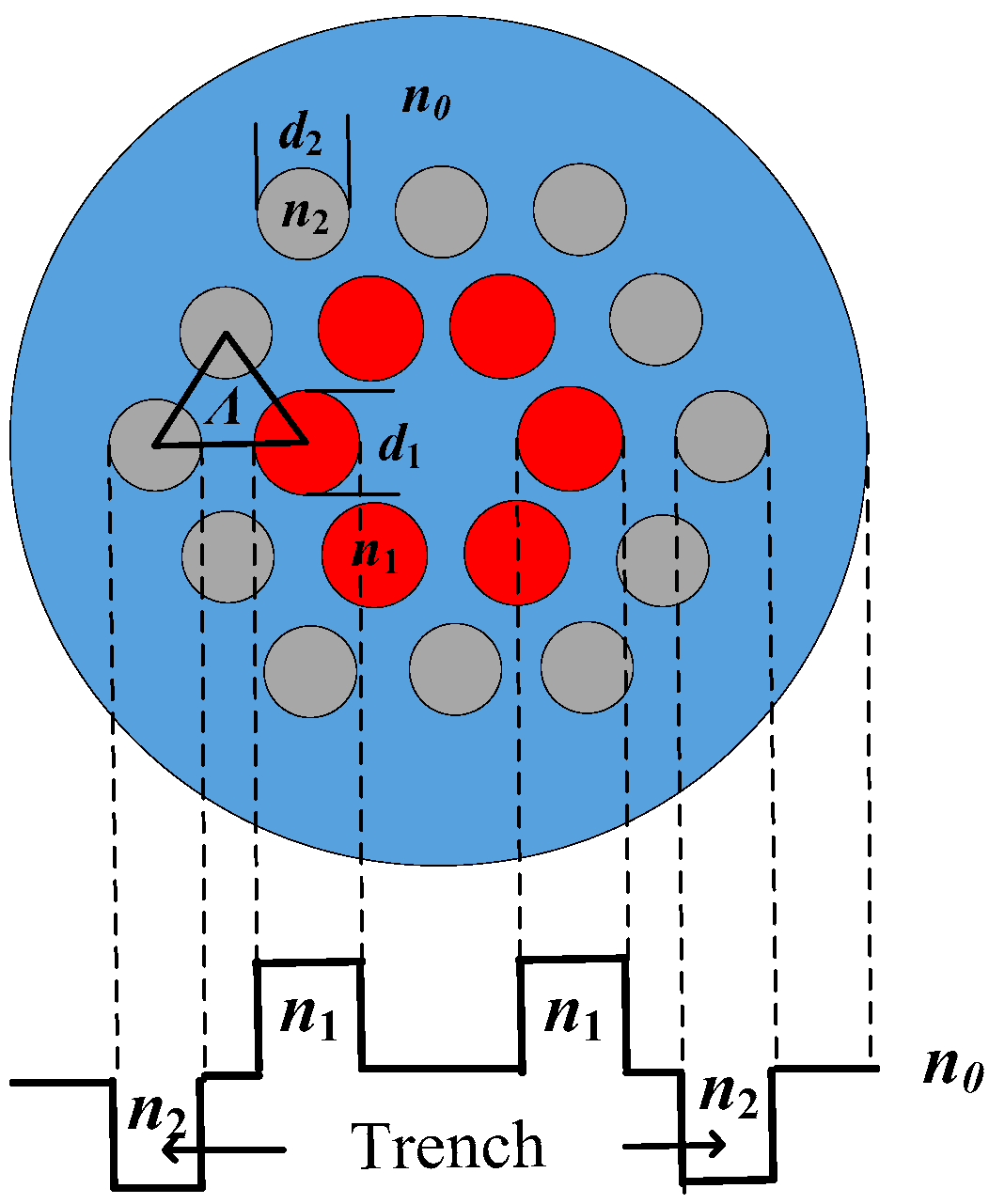

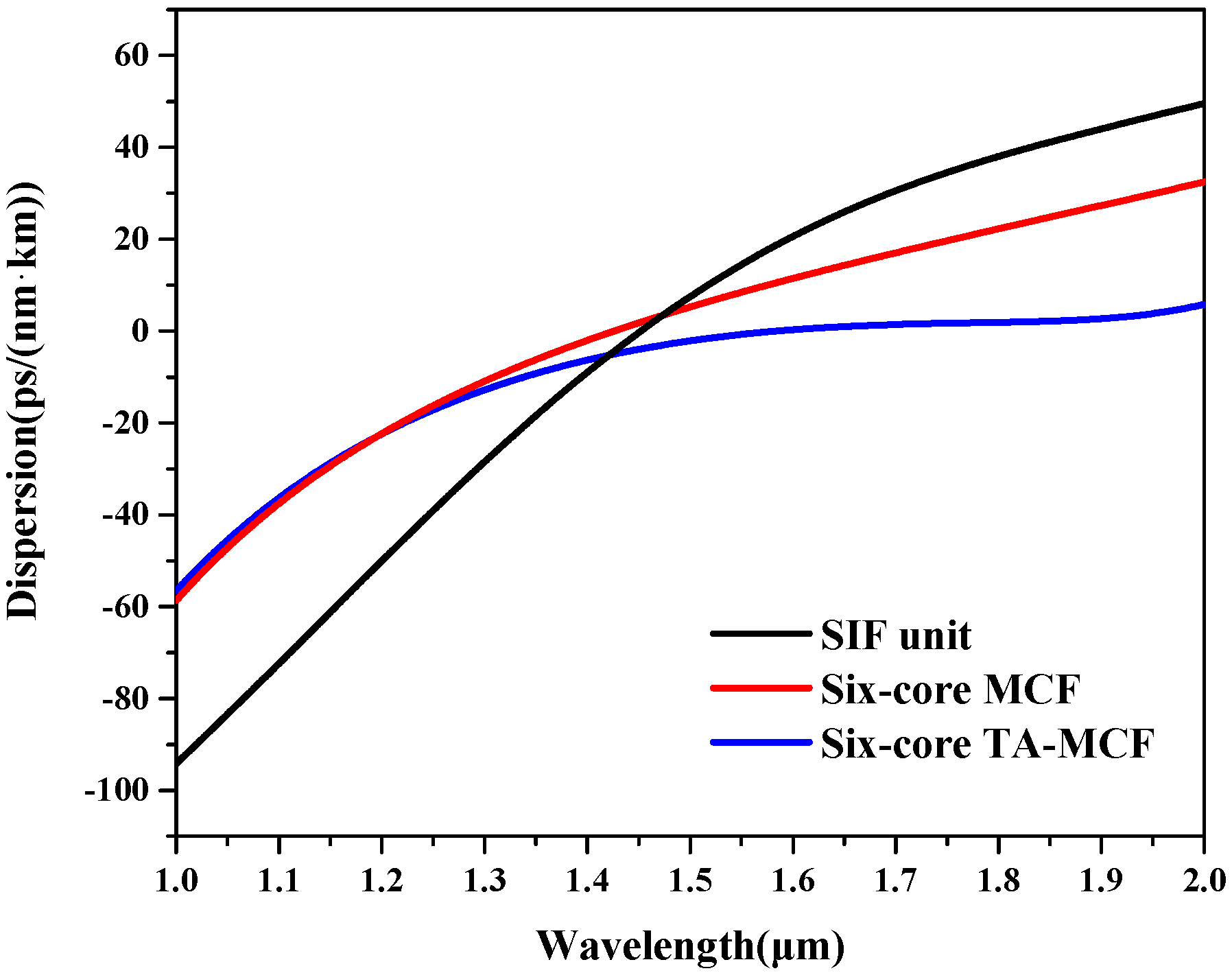
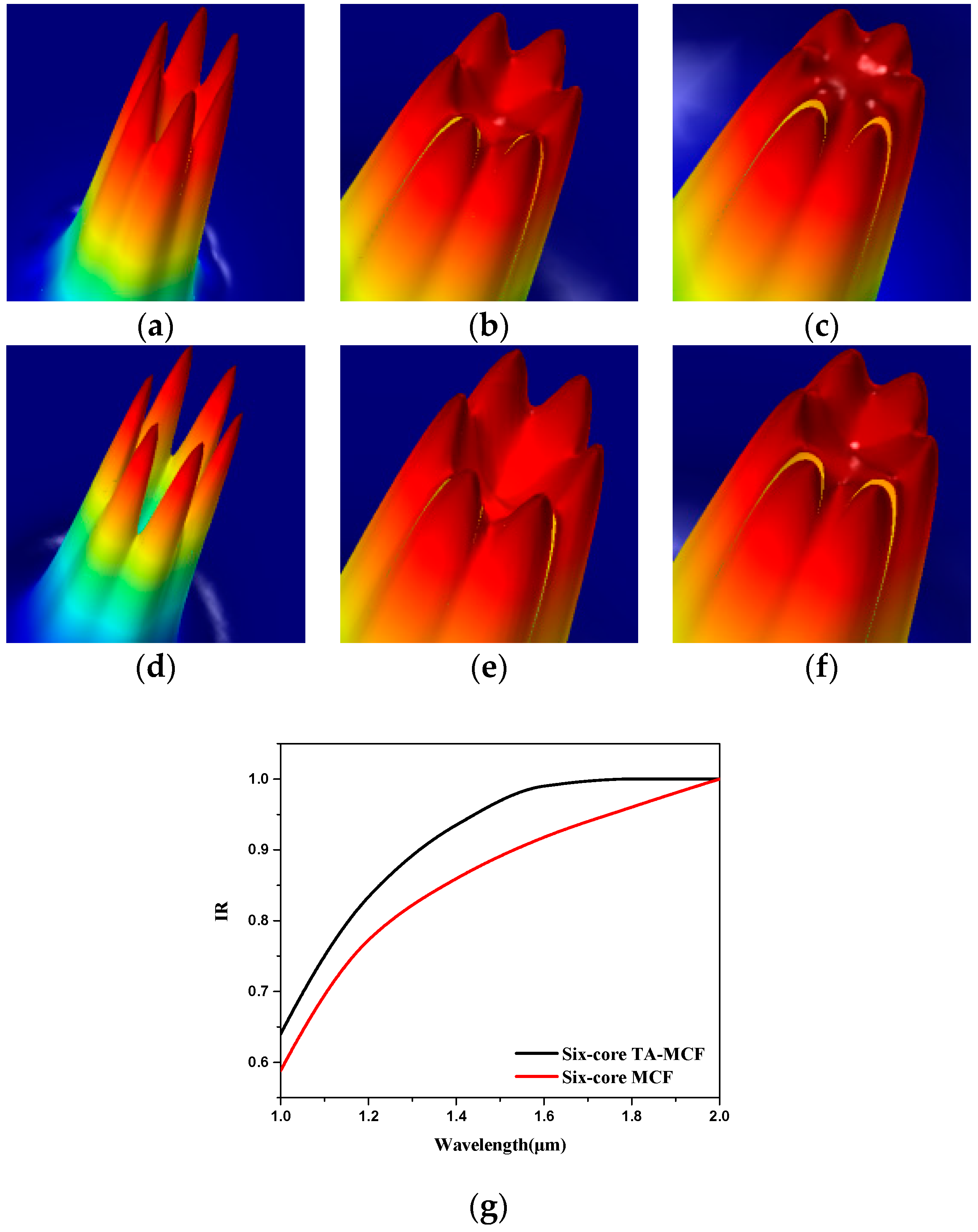
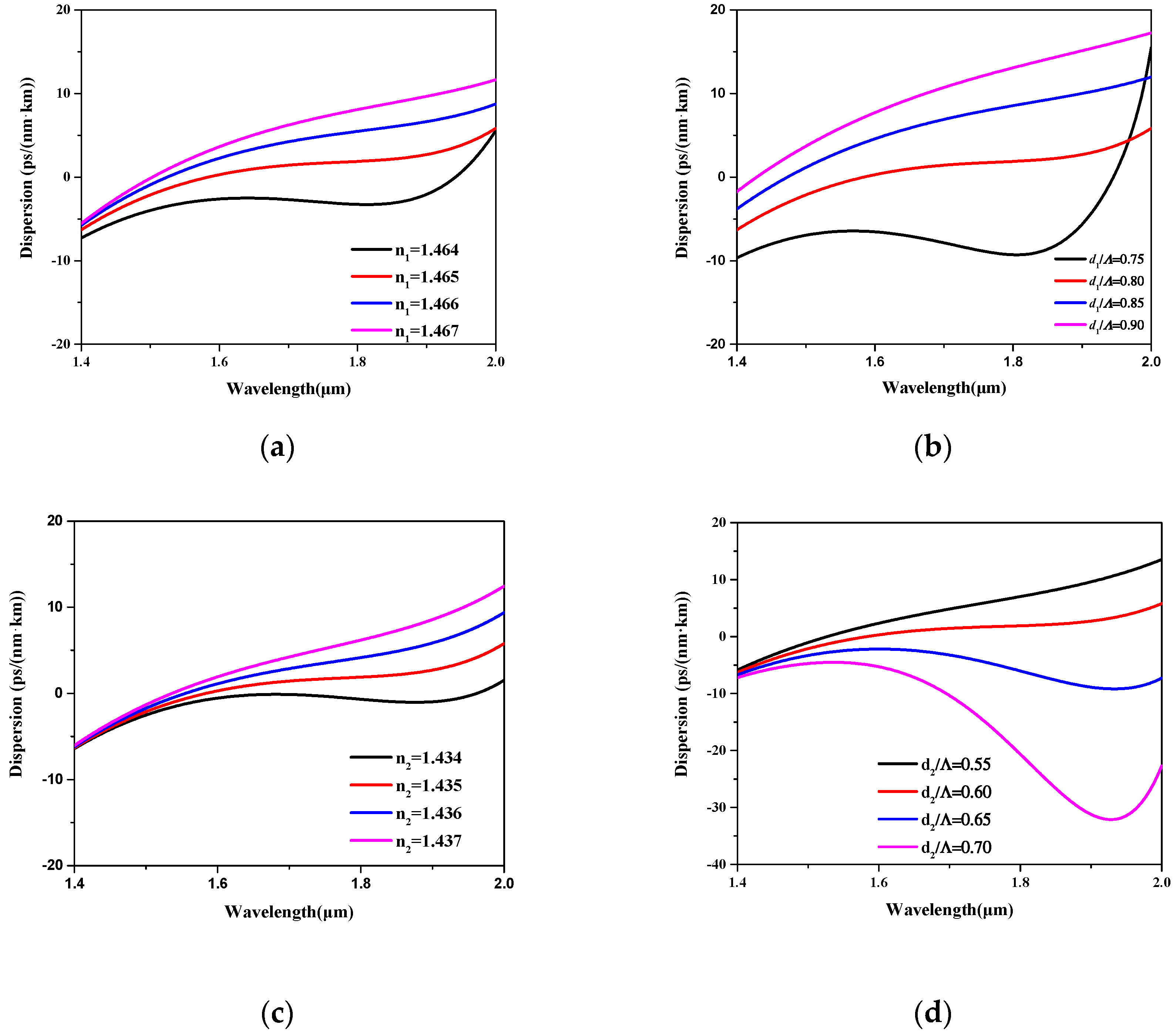
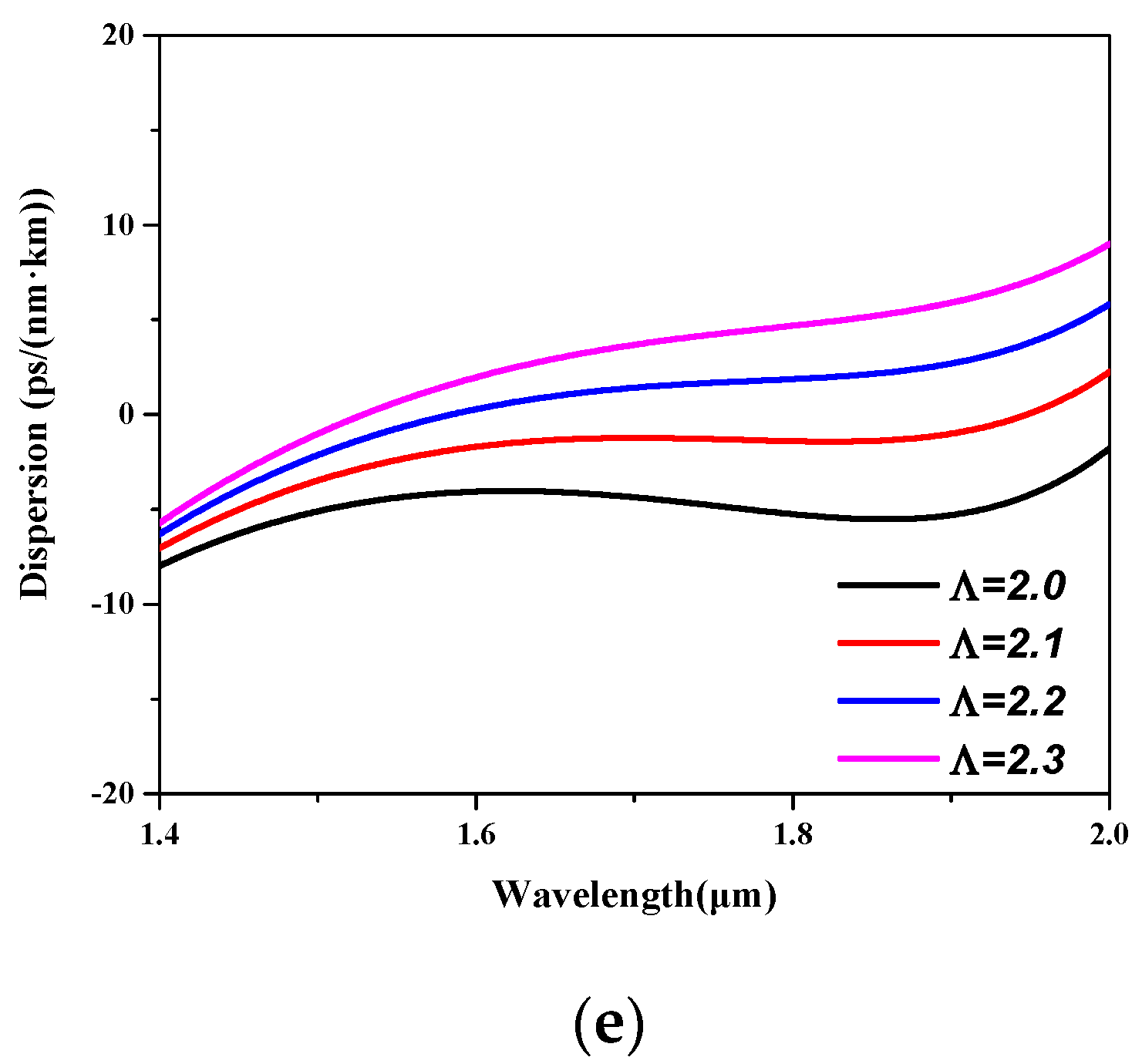
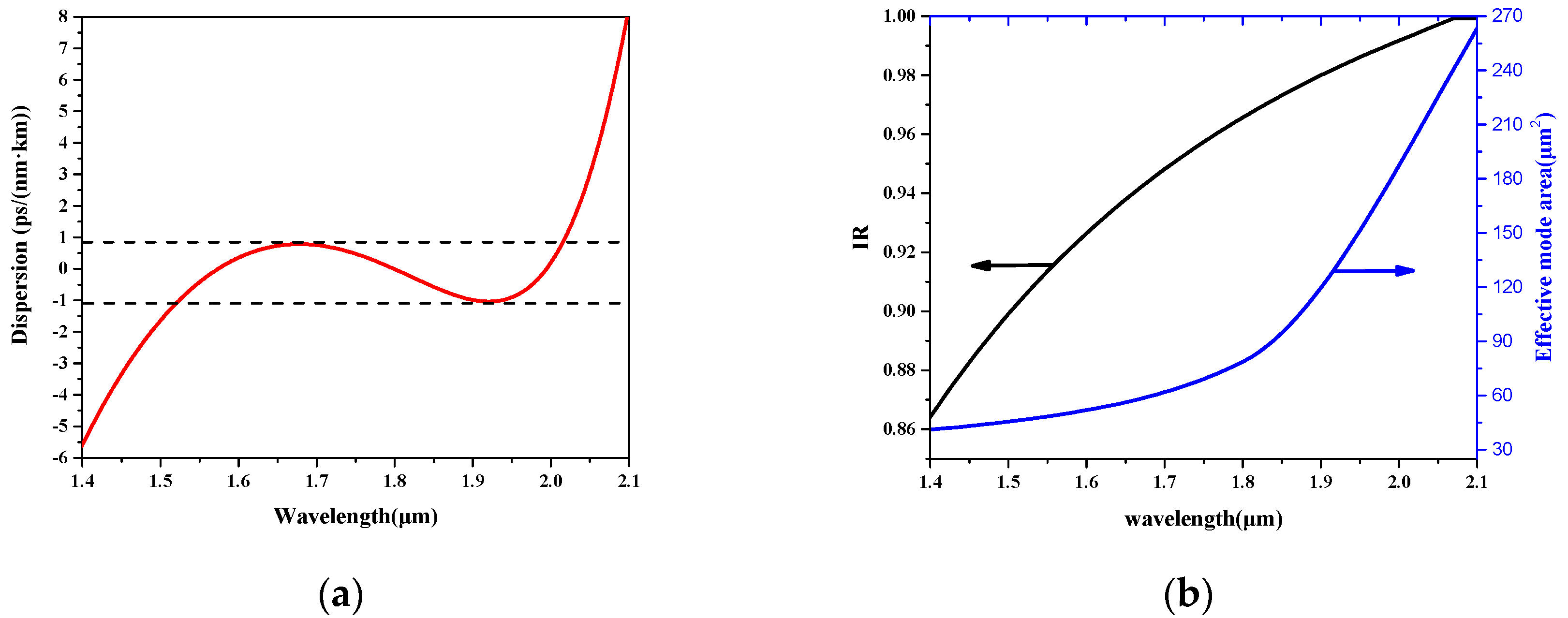


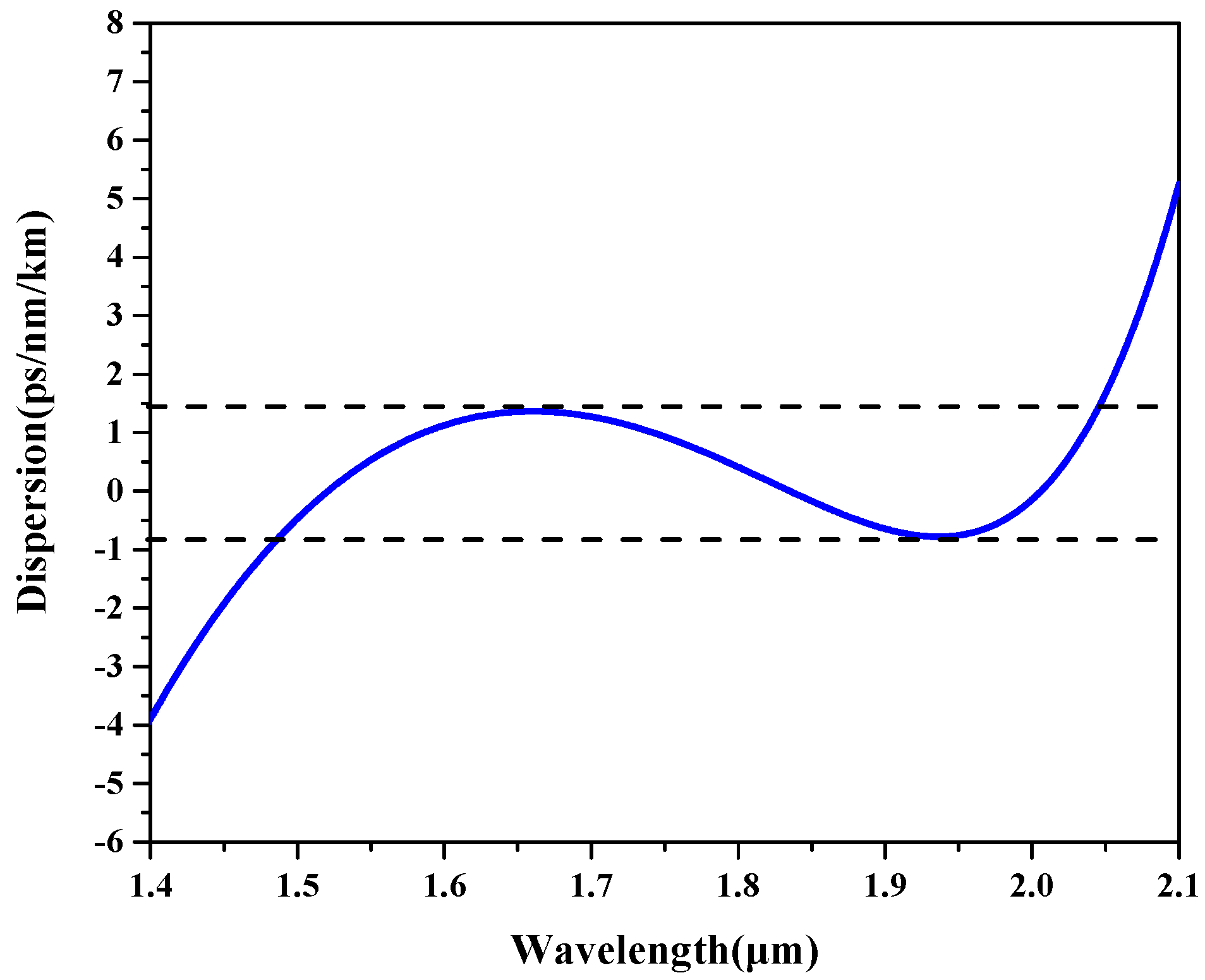

| Reference | Aeff @1550 nm (μm2) | Fiber Structure | Dispersion | ||
|---|---|---|---|---|---|
| Number of Air Holes or Inclusions | Material | Interval ps/(nm·km) | Wavelength Window/Range (nm) | ||
| [8] | 8.55 8.95 | 126 | Air–silica | 0 ± 0.5 0 ± 0.4 | 1190–1690/500 1230–1720/490 |
| [9] | 13.2 | 60 | Air–silica | 0 ± 0.25 | 1295–1725/430 |
| [10] | 10.86 | 126 | Air–silica | 0 ± 0.25 | 1410–1640/230 |
| [11] | 7.64 | 37 | Air–silica | 0 ± 0.5 | 1100–1700/600 |
| [12] | 5 7 | 168 | Two soft glasses: F2 (nF2 = 1.594874 at λ =1.55 μm) NC21 (nNC21 = 1.5113 at λ = 1.55 μm) | −29.25 ± 4.25 −95.5 ± 8.5 | 1370–2620/1250 1120–2280/1160 |
| [13] | 7 | 168 | Two soft glasses: F2 (nF2 = 1.594874 at λ = 1.55 μm) NC21A (nNC21A = 1.5113 at λ = 1.55 μm) | −50 to −30 | 1100–2700/1600 |
| [14] | - | 276 | Air–silica | 0 ± 3.4 | 1373–1627/254 |
| [15] | -- | 126 | Air–silica | 0 ± 1.00 0 ± 1.50 | 1262–1722/460 1218–1750/532 |
| [16] | - | 109 | Air–silica | 0.82 ± 0.30 | 1120–1510/390 |
| Proposed 1 Proposed 2 | 48.41 42.80 | 18 19 | Germanium-doped and fluorine-doped silica glass | −1.03 to 0.75 −0.46 to 1.35 | 1520–2010/490 1500–2040/540 |
© 2018 by the authors. Licensee MDPI, Basel, Switzerland. This article is an open access article distributed under the terms and conditions of the Creative Commons Attribution (CC BY) license (http://creativecommons.org/licenses/by/4.0/).
Share and Cite
Wang, W.; Qiu, S.; Xu, H.; Lin, T.; Meng, F.; Han, Y.; Qi, Y.; Wang, C.; Hou, L. Trench-Assisted Multicore Fiber with Single Supermode Transmission and Nearly Zero Flattened Dispersion. Appl. Sci. 2018, 8, 2483. https://doi.org/10.3390/app8122483
Wang W, Qiu S, Xu H, Lin T, Meng F, Han Y, Qi Y, Wang C, Hou L. Trench-Assisted Multicore Fiber with Single Supermode Transmission and Nearly Zero Flattened Dispersion. Applied Sciences. 2018; 8(12):2483. https://doi.org/10.3390/app8122483
Chicago/Turabian StyleWang, Wei, Shi Qiu, Haidong Xu, Tianxu Lin, Fanchao Meng, Ying Han, Yuefeng Qi, Chao Wang, and Lantian Hou. 2018. "Trench-Assisted Multicore Fiber with Single Supermode Transmission and Nearly Zero Flattened Dispersion" Applied Sciences 8, no. 12: 2483. https://doi.org/10.3390/app8122483





